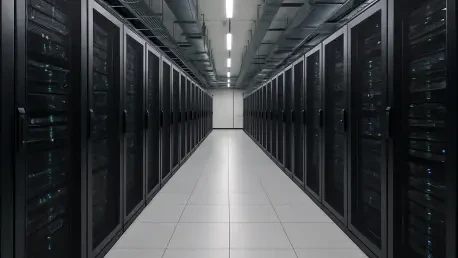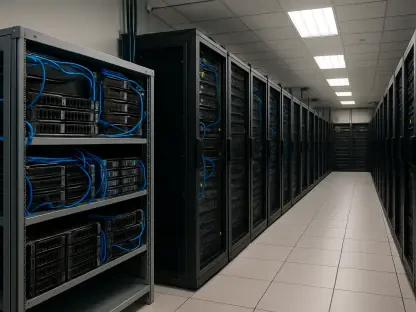What happens when a small nation becomes the backbone of Europe’s digital economy? The Netherlands, with a land area smaller than many US states, processes a staggering volume of global internet traffic, positioning itself as a titan in the data center industry. As of 2025, the market stands at a robust $6.42 billion, with projections to reach $9.02 billion by 2030 at a steady growth rate of 7.04% annually. This remarkable ascent isn’t just about numbers—it’s a story of innovation, sustainability, and strategic brilliance that demands attention from tech leaders and policymakers worldwide.
The significance of this growth lies in its global implications. Data centers are the invisible engines powering everything from streaming services to artificial intelligence, and the Dutch model offers a blueprint for balancing expansion with environmental responsibility. With digital consumption skyrocketing, understanding how a country occupying just 0.3% of its industrial land for these facilities handles such demand is critical. This narrative unfolds the strategies, challenges, and future pathways that make the Netherlands a standout in a crowded field.
Why the Netherlands Dominates Europe’s Digital Scene
At the heart of Europe, the Netherlands has carved out a niche as a digital powerhouse, thanks to its unparalleled connectivity. Amsterdam alone serves as a major internet exchange point, handling a significant portion of the continent’s data traffic. This strategic positioning, coupled with robust infrastructure, makes the country a magnet for tech giants seeking reliable, high-speed operations.
Beyond geography, the Dutch commitment to efficiency sets a high bar. Despite a decade of flat electricity consumption, the nation manages ever-increasing data loads with finesse. This isn’t luck—it’s the result of deliberate investment in cutting-edge cooling technologies and optimized facility designs that maximize output without draining resources.
The impact is tangible for businesses worldwide. Companies like Netflix rely on Dutch hubs to deliver seamless streaming to millions, showcasing how a compact nation can support global digital demands. This unique blend of location and innovation underscores why the Netherlands isn’t just participating in the data race—it’s leading it.
The Strategic Advantages of the Dutch Data Ecosystem
Delving deeper, the Netherlands benefits from a rare alignment of policy and infrastructure. The country’s role as a central hub for internet traffic intersects with a forward-thinking regulatory environment that prioritizes both growth and sustainability. This balance is crucial as digital consumption surges, creating pressure on grids and ecosystems across the globe.
Amsterdam’s prominence as a connectivity node is no accident. Its dense network of fiber-optic cables and proximity to major markets ensure low-latency access, a must for industries like finance and gaming. Yet, this advantage comes with challenges, such as the need to manage grid stability while accommodating hyperscale facilities that power cloud computing.
Environmental concerns also loom large. The Dutch approach integrates sustainability into the core of data center operations, addressing global calls for greener tech solutions. This focus not only mitigates impact but also positions the country as a case study for others grappling with similar issues, highlighting the broader relevance of its strategies.
Key Factors Fueling Growth and Innovation
Several elements drive the Dutch data center boom, starting with sustainable efficiency. A staggering 90% of the energy used by these facilities comes from renewable sources, allowing massive data processing without a corresponding spike in carbon footprints. This model proves that growth and environmental stewardship can coexist.
Regulatory frameworks further shape the landscape. Since early 2024, new rules restrict hyperscale data center locations to designated zones like Eemshaven, while Amsterdam caps new projects at 670 MVA unless they serve local needs. These measures push the industry toward innovative edge computing setups, distributing smaller facilities closer to users for faster response times.
Technology itself is evolving rapidly. The shift from mere data storage to processing-intensive tasks supports sectors like AI and streaming, with real-time demands necessitating edge infrastructure. Examples abound—think of Tesla’s reliance on Dutch centers for operational data or Amsterdam’s role in routing Europe’s internet backbone, illustrating how these drivers translate into real-world impact.
Insights and Challenges from Industry Experts
Voices from the field add depth to this story, painting a picture of a mature market poised for transformation. At events like the Data Centre Expo in Amsterdam, industry leaders consistently highlight the Netherlands’ readiness for edge computing, driven by its established infrastructure. Yet, they also point to hurdles like cybersecurity risks in distributed systems.
Operational challenges are a recurring theme. A notable concern is the skills gap in managing hybrid cloud environments and AI workloads, critical for future growth. One expert noted during a panel discussion, “The speed of tech adoption outpaces talent development—bridging that gap is urgent.” This sentiment reflects a broader need for specialized training to keep pace with innovation.
The sector’s economic weight offers perspective on its stakes. Supporting 11,000 direct jobs and contributing to 2.1 million digital economy roles, the industry is a cornerstone of national prosperity. Stories of global firms depending on Dutch facilities for secure, high-speed operations underscore the trust placed in this market, even as it navigates complex threats and talent shortages.
Practical Pathways for Stakeholders in the Future
For those eyeing engagement with this dynamic sector, actionable strategies emerge from the Dutch experience. First, adopting distributed models is key—smaller, edge-focused facilities align with regulatory trends and meet the low-latency needs of IoT and AI applications. This shift ensures relevance in a rapidly changing landscape.
Investment in skills development stands as another priority. With a vast talent pool already in place, stakeholders should focus on training for hybrid cloud and cybersecurity expertise to address critical gaps. Leveraging the existing 2.1 million digital economy jobs can provide a strong foundation for scaling capabilities.
Finally, sustainability must remain central. Emulating Dutch practices, such as integrating green energy and efficiency measures, offers a path to balance expansion with environmental goals. These steps form a practical roadmap, tailored to meet evolving demands and ensuring that businesses, investors, and policymakers can draw meaningful lessons from this market’s success.
Reflecting on a Digital Legacy
Looking back, the journey of the Dutch data center market unfolded as a testament to strategic vision. The nation’s ability to grow from a $6.42 billion industry in 2025 to a projected powerhouse by 2030 reflected a rare synergy of innovation and responsibility. Each milestone, from sustainable energy adoption to regulatory adaptation, built a foundation that reshaped Europe’s digital frontier.
The challenges tackled along the way—grid stability, skills shortages, and cybersecurity—offered lessons for global markets. For stakeholders, the next steps involved embracing edge computing, prioritizing talent development, and committing to green practices. These actions promised not just to sustain momentum but to redefine how digital infrastructure could harmonize with societal needs.
Ultimately, the Dutch example stood as an inspiration. Future considerations hinged on collaboration across sectors to replicate this balance of growth and sustainability elsewhere. By focusing on distributed systems and renewable integration, the path forward became clearer, inviting a renewed commitment to building digital ecosystems that served both technology and the planet.









